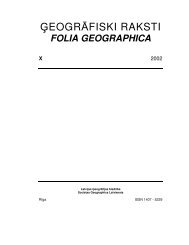eogrÄfiski raksti folia geographica xii - Ä¢eogrÄfijas un Zemes zinÄtņu ...
eogrÄfiski raksti folia geographica xii - Ä¢eogrÄfijas un Zemes zinÄtņu ...
eogrÄfiski raksti folia geographica xii - Ä¢eogrÄfijas un Zemes zinÄtņu ...
You also want an ePaper? Increase the reach of your titles
YUMPU automatically turns print PDFs into web optimized ePapers that Google loves.
HUMAN GEOGRAPHY<br />
are also main centres of agglomeration in Jelgava, Jurmala, Tukums, Kalnciems, Sigulda,<br />
Līgatne, and Aizkraukle in the centripetal zone of Riga. [Filimonenko 1989, Bauls et al. 1999].<br />
Internal migration flows and their trends in Latvia*<br />
1993 1998 2000 2002<br />
68<br />
Table 3<br />
Amo<strong>un</strong>t % Amo<strong>un</strong>t % Amo<strong>un</strong>t % Amo<strong>un</strong>t %<br />
Total flows 37046 100 38729 100 34989 100 31413 100<br />
1.Urban-urban 11068 30 11711 30 11224 32 10028 31<br />
Urban-rural 11734 32 11542 30 10839 31 9272 30<br />
Rural-urban 8892 24 11217 29 9674 28 7734 25<br />
Rural-rural 5352 14 4259 11 3252 9 4379 15<br />
2.To cities 19960 54 22928 59 20898 60 17662 56<br />
to rural areas 17086 46 15801 41 14091 40 13751 44<br />
3.From cities 22802 62 23253 60 22063 63 19300 61<br />
from rural areas 14244 38 15476 40 12926 37 12113 39<br />
* Calculated according [LR CSP/CSBL - Central Statistical Bureau of Latvia]<br />
Migration from the rural areas to the city traditionally involves so-called gradual<br />
migration. The more complex is metropolitan area, the greater the probability that gradual<br />
migration will take place. Satellite centres may absorb all of the migrants from rural areas. In<br />
co<strong>un</strong>tries where urbanisation is in its infancy, migration usually flows from rural areas to the<br />
centre of the metropolitan area, thus increasing the process of concentration in the centre to an<br />
even greater degree [Prothero 1988].<br />
In the 1990s, there was a short period of ruralisation, which was expressed in dominating<br />
population outflows from Riga and other major cities.<br />
Why have urban residents been moving to the rural areas? The main reason is that after<br />
World War II people had moved from the rural areas to the cities, i.e., from the peripheral<br />
regions to the central part of the co<strong>un</strong>try. People moved from single-family farms to rural<br />
villages, particularly the so-called “emergent villages” (perspektīvie ciemati) [Markausa 1997].<br />
In the 1990s, studies showed that the denationalisation of property in the rural areas led<br />
considerable numbers of people to move back to their ancestral homes in rural areas. Yo<strong>un</strong>g<br />
people and people of retirement or pre-retirement age were particularly ready to make the move.<br />
People who moved to Riga from rural areas in the 1960s were particularly prone to make the<br />
move.<br />
During the initial years of land reform after regaining the independence in the beginning<br />
of 1990s, the number of people in more distant Latvian districts, particularly in the far eastern<br />
region of Latgale, increased more swiftly than was the case in the central part of the co<strong>un</strong>try,<br />
because greater numbers of people had left Eastern Latvia during the previous decades (for<br />
work in the cities) [Eglīte 1997, Markausa 1997]. Many researchers say that this is a<br />
phenomenon typical to transition periods, because surveys show that rapidly shifting socioeconomic<br />
factors were key reasons why people chose to move [Markausa 1997]. Trends in the<br />
flow of domestic migration in later years showed that these were only temporary flows and<br />
motivations. Unfavourable socio-economic conditions, including a high level of <strong>un</strong>employment<br />
and a lack of jobs, led to a different migration flow, with people once again flowing away from<br />
the peripheral districts of the co<strong>un</strong>try. This has been shown through increased migration from<br />
Latgale to the central part of the co<strong>un</strong>try since 1998. The number of people arriving in Riga<br />
from Latgale has increased from year to year. In 1993, 13% of all people who moved to Riga<br />
came from Latgale, while in 2002 the percentage was up to 15% (in 2000 15%) [LR CSP/CSBL<br />
1994-2003].

















